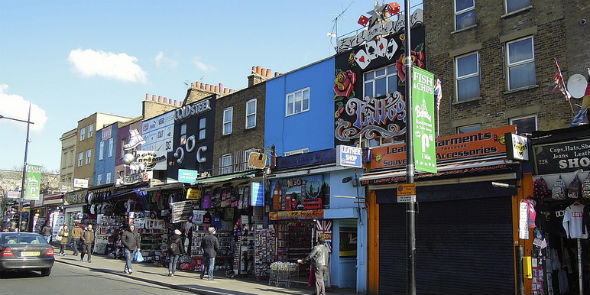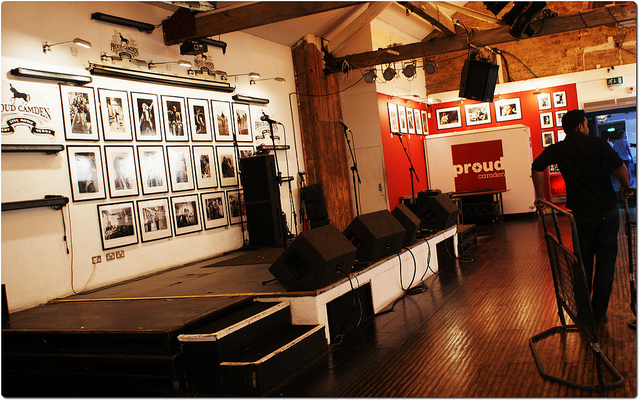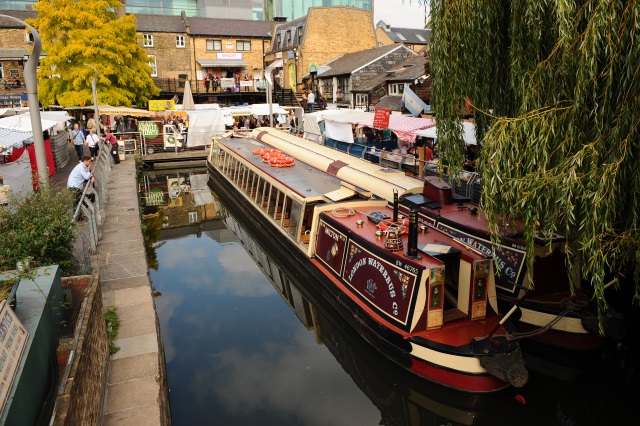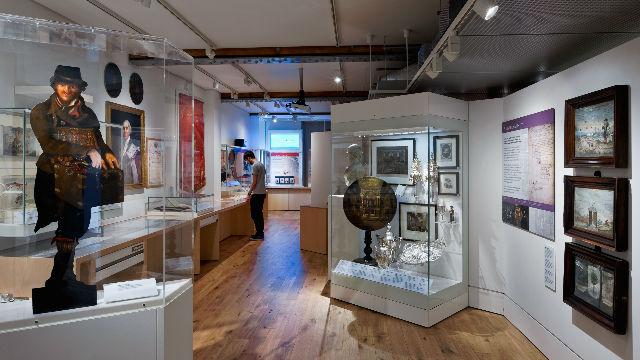In years gone by, the London suburb of Camden would conjure up images of grotty pubs filled with grimy rockers with studs and rings in their clothes and bodies. For many people Camden was a scary place that should be left to consume itself, but a concerted effort by local authorities in the last 20 years has seen Camden rocket up the list of the most interesting and exciting places to visit in London.

Camden High Street . (Photo: David McKelvey via Flickr)
So where is Camden, what goes on there and why does it deserve your attention?
The whats and wheres of Camden
Towards the end of the 18th century, politician and Earl Charles Pratt started allowing development of houses on his Kentish Town estate, and Camden Town was born. The boring of the Regent’s Canal through the area in 1816 cemented the image of Camden as a functional but not particularly fashionable district; it wasn’t until the arrival of the Camden Market in the mid-1970s that the area started to command more attention.
Nevertheless it remained a quirky place, unloved by most aside from its residents, until the 1990s when it became synonymous with the rise of the musical phenomenon that was Britpop. The sudden influx of music-hungry teenagers looking for a glimpse of their favourite stars in the Good Mixer pub forced the local authorities to start a low-key clean-up operation in Camden.
Camden is just up the map from Euston, Kings Cross and St Pancras mainline stations. The easiest route to Camden is via the London Underground’s Northern line – every Northern line train goes through Camden Town, so you can’t miss it. You can also use Camden Road station via the London Overground network to travel from faraway parts of London such as Croydon, Wembley, Stratford and Richmond.
Music: the heart of Camden
No article about Camden can be taken seriously unless it gets straight to the heart of what the area is most famous for: its music.
Although upstart districts to the east such as Shoreditch and Dalston are trying to wrest the crown from Camden, it remains packed with small and medium-sized venues to see live music and is a must-play for any band on their rise to the top. Over the years there can be few famous bands and singers that haven’t graced a Camden stage; The Clash, The Who, Jimi Hendrix, Oasis, Coldplay, Radiohead and many, many more have all blasted through this part of town.
Some of London’s most well-known venues can be found in Camden. The Barfly is where to find cutting-edge new music on their way to fame. The Electric Ballroom is where global superstar Prince recently landed in the city to thrill a small crowd. The Jazz Cafe is Camden’s home of not just jazz but blues, funk and even the odd rock gig. The Underworld is the area’s premier punk rock nightspot, beneath the famous World’s End pub. And the Roundhouse, Camden’s largest venue, not only puts on huge shows from some of the country’s biggest rock acts but also dance, cabaret, classical performances and just about anything else beneath its giant dome.
One of the newer venues in the area, but already a huge player on Camden’s live music scene, is Proud Camden. Situated in a listed building at the heart of Camden’s stables market, Proud Camden has been lovingly built by music fans and is decorated with Camden’s rich rock history around its walls.

Proud Camden (Photo: Steffi Njoh Monny via Flickr)
Bands and DJ sets are common at Proud Camden but the venue has also built up a tradition of club nights, such as the excellent Witness the Fitness beats and disco event, plus more unusual musical treats such as Proud Cabaret, giving north London its first serious taste of the burlesque.
Proud Camden is one of the latest venues to be embraced by Camden as it continues to prove it’s not yet ready to give up the honour of being the capital’s favourite live music hub.
Eat, drink and be merry in Camden
Beyond its music, the area is also filled with excellent places to eat and drink, including of course some of the most characterful and unique pubs in London.
For a genuine taste of Camden, it’s best to head to one of the classic Camden pubs that have hardly changed over the years. The Elephants Head has mellowed a little from its former rockers’ paradise, but its jukebox and relaxed atmosphere still makes it one of Camden’s finest pubs. Those rockers who steadfastly refuse to grow up probably now inhabit The Hobgoblin, which from the outside seems to be a frightening establishment but is actually just a home for those of a more punk and metal persuasion.
The Monarch along Chalk Farm Road is a pub that doubles up as a live venue, while The Enterprise offers a more relaxed environment to sit and contemplate a part of town teeming with life and every type of drinking den imaginable.
As for food, Camden may not be well known for its fancy restaurants and high-class dining options, but it certainly underlines London’s multicultural aspect with its choice of places to eat.
Shaka Zulu is London’s largest South African restaurant, and certainly worth a visit if you can’t get enough of your beef bobotie (curried mince and spices) and boerewors (traditional southern African sauage). Shaka Zula’s meats are cooked on a classic ‘braai’, the type of barbecue held so dear by the many South Africas, Zimbabweans and Botswanans who have made London their home.
On Inverness Street meanwhile you can find Made In Brasil, which aims to bring the best of Brasilian culture, food and drink to Camden. This vibrant restaurant offers an excellent experience in Latino culture and the menu includes sizzling seafood and succulent slabs of South American beef, perhaps washed down with a traditional ‘Caipirinha’, Brazil’s national cocktail.
But you don’t have to sit down to enjoy a tasty treat in Camden, because street food is a crucial part of the area’s culinary offering. Camden Lock Market is one of the finest places in London to sample anything from Asian fusion to posh, spice-laden burgers, and some of the most flavourful vegetarian food available anywhere.
You can wash all this down with a huge variety of fruit juices, teas and coffees, and curious beverages that you will only find the courage to try in Camden. But Camden Lock Market is not just famous for its food – it also offers a way into another of Camden’s vital organs, its shopping.
Camden’s markets
Camden has a selection of distinct markets with very similar names, and it’s sometimes tricky to know where one market ends and another begins.

The London Waterbus. (Photo: Courtesy of Camden Lock Market)
Camden Lock Market is the original and most famous market in the area. It began as an arts and crafts market in the 1970s and has grown to become a buyer’s paradise in the heart of north London. Camden Lock Market sits next to Chalk Farm Road and includes the famous Market Hall, a three-storey home to more than 100 traders of jewellery, ceramics and all manner of artwork. It also includes the West Yard, home to a huge array of street food, from Peruvian to Ethiopian, plus the London Waterbus, offering picturesque boat tours along the Regent’s Canal.
Camden Lock Market was fortunate to survive unscathed from the Camden Market Fire of 2008, which affected the railway and many small businesses, including the Hawley Arms pub (haunt of local hero and much-missed singer Amy Winehouse). Not so lucky was the Camden Lock Village Market – the second of Camden’s famous markets, on the other side of Chalk Farm Road. This was where the 2008 fire is believed to have started, and though it was badly damaged it has bounced back to offer the coolest in current fashions; trends have often started in Camden – not all of them successful, some laughable but all memorable.
From t-shirts to trilbys, frocks to fedoras, you’ll find some version of what you’re looking for in this part of the market. There are also clothes on offer at the Camden Market (also known as the Buck Street Market), a little way back towards the underground station from the other sections.
A short distance to the north, across the street you will find the Camden Stables Market, home of the Proud Camden venue. This is where you’ll find the cutting edge of Camden’s fashion and arts, the hottest new looks, the most unique home decoration, worldwide cuisine food courts and some of the best themed restaurant bars in London. The Stables Market is a part of Camden you can lose hours in, only to come back the following week and do it all again.
With an estimated 40 million visitors per year, it’s fair to say the Stables Market has a claim to be one of the most popular tourist attractions in north London. But if it’s not shopping you’re looking for, Camden has plenty more to offer the discerning visitor.
Camden’s cultural highlights
Although it won’t claim to match central London’s huge wealth of tourist attractions, Camden has its fair share of interesting spots to live and learn.
On the edge of Camden Town sits the world’s oldest scientific zoo and conservation zone: London Zoo. At the forefront of animal conservation and with a strong reputation for the careful management and study of its many species, ZSL London Zoo holds everything from exotic bird species to bugs, tropical wonders and tigers.
Sitting at the northern edge of one of London’s most famous green spaces, Regent’s Park, it’s worth dedicating a whole day to nature, with a peer at the animals and a stroll in the huge open space created by the architect John Nash during the regency and reign of King George IV.
London has a strong Jewish contingent and this is celebrated in the Jewish Museum, between the underground station and the zoo on Albert Street. Originally created to celebrate the strong Jewish connections of London’s East End, it has grown to encompass all parts of the city’s Jewish history and relocated to its Camden premises in 2010.

Jewish Museum London interior. (Photo: Visit London)
Within the museum you can learn about the history of Judaism in London, how Jewish people have influenced the life of the city and the work of some of the most famous Jewish people to have spent time in the capital. The museum houses one of the world’s finest collections of Judaica, featuring objects used in all areas of Jewish religious life and Jewish art from around the world. (Note: the museum is closed on Saturdays to observe the Sabbath.)
Flowing right through the centre of Camden Town and the areas to the east and west is one of the best-kept secrets in town – the Regent’s Canal. Once a run-down aspect of London used solely for boating access from one area to another, the regeneration of the canal and surrounding area has been one of the finest aspects of Camden’s recent makeover. A stroll along the canal’s towpaths, or just a few minutes sitting and watching the barges float by, surrounded by spectacular wildlife and flora, is a delightful way to spend time in the city. But if you’re the more active type, you can even have a go on the water yourself courtesy of the Pirate Castle.
A boating and activities company based on the canal, the Pirate Castle offers kayaking, canoeing and boating of various styles and standards. You can take lessons on the water from the company’s crew of trained staff, coaches and volunteers, and adults and children are welcome. Within the castle building itself they even put on special classes in things like yoga, taekwondo, drumming and dance. It is a charitable organisation and a wonderful example of how you can find pretty much anything you can think of to see or do in Camden Town.
A distinct and diverse star of the north
The key to Camden is its diversity. Everyone is welcome in the area, from temporary visitors and tourists to those who come for a visit but find they end up staying. Camden is famous for its musical heritage and has long treasured its grungy reputation, but there’s no denying it has become one of the most attractive parts of the city to see, hear, shop and play.
Though some hanker for Camden’s perhaps more colourful days gone by, most agree that the partial makeover of the area has been to the benefit of residents, other Londoners and tourists alike. Deep down, however, Camden will also always provide a haven for society’s outsiders and strays, and long may that remain the case.